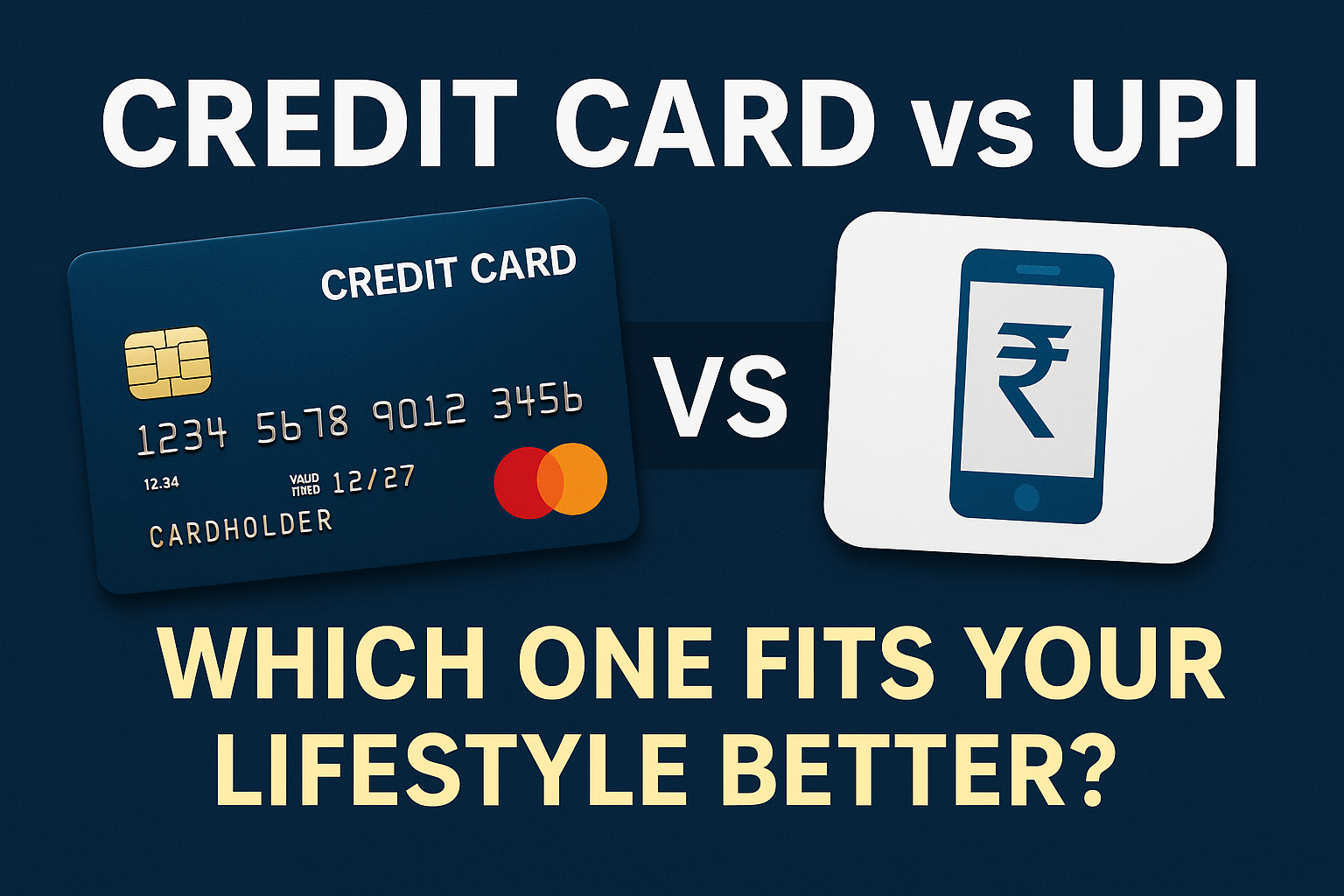Table of Contents
In today’s fast-evolving digital world, the debate between credit card vs UPI is more relevant than ever. Whether you’re buying groceries online or paying for your morning coffee, chances are you’re choosing between swiping a credit card or scanning a UPI QR code. But which one truly works better for you?
Let me start by sharing a real story.
I was in a local electronics store a few months ago, buying a wireless headphone. When I reached the billing counter, the staff asked, “Sir, credit card or UPI?” That seemingly simple question triggered a long train of thought in my head.
Back then, I had both options. I used my credit card for cashback offers, but I also knew UPI was faster and required no interest payments. That one moment made me start comparing credit card vs UPI more closely—and here’s what I’ve learned from months of real-life use, case studies, and numbers.
Let’s break it all down.
What is a Credit Card and How Does It Work?

Credit cards have been around for decades. They are essentially small loans offered by banks. Every time you swipe your credit card, you’re borrowing money from the bank, which you are supposed to pay back within a billing cycle, typically 30 days.
If you repay the amount before the due date, you don’t pay any interest. But if you delay it, interest can range from 2% to 4% per month (yes, per month, not year).
Banks also offer reward points, cashback, EMI conversions, travel benefits, and credit score building through credit cards. For those who know how to manage credit wisely, this is gold.
But what about UPI? Is it more efficient, or just another payment method?
What is UPI and How Is It Different?
UPI stands for Unified Payments Interface. It’s a real-time payment system developed by the National Payments Corporation of India (NPCI), enabling users to link their bank account and make direct bank-to-bank transfers using a mobile app.
Unlike credit cards, UPI doesn’t offer you a loan. It simply moves money from your bank account to another instantly. You can pay bills, send money to friends, shop online, and more—all without needing a card, cash, or even knowing the recipient’s bank account number.
The core difference in credit card vs UPI is this: credit cards are borrowing tools, UPI is a transfer tool.
Fees and Charges: The Hidden Cost Comparison
One of the biggest reasons people choose UPI is because it’s practically free. Whether you’re sending ₹10 or ₹10,000, UPI usually doesn’t charge anything. That’s powerful.
Credit cards, on the other hand, come with multiple fees:
- Annual Fees (₹500–₹5000)
- Late Payment Charges
- Interest on Outstanding Amount
- Foreign Transaction Charges
In a comparison of credit card vs UPI, the latter wins in cost-efficiency.
Let me tell you what happened to my friend Aniket. He paid ₹12,000 on his credit card and missed the due date by five days. The bank charged him ₹500 late fee and added ₹380 interest. That ₹12,000 purchase cost him nearly ₹900 extra.
With UPI? That would’ve never happened.
User Experience and Speed: Which One Is Smoother?
Imagine you’re in a crowded grocery store. The queue is long. You reach the counter. You swipe your credit card, wait for OTP or PIN, and then the payment goes through.
Now imagine opening your UPI app, scanning the QR, entering your PIN, and done. It’s that simple.
The seamless experience of UPI is one reason why its adoption exploded in India. In fact, UPI crossed 13 billion transactions in a single month (Feb 2024). That shows how India is shifting from cards to UPI.
Still, credit card vs UPI has another angle: offline vs online usage.
UPI struggles sometimes with poor internet. Whereas credit cards can work offline using Point-of-Sale (PoS) terminals, especially in remote areas.
So while UPI wins in speed and simplicity, credit cards have the edge in offline availability.
Security: Which is Safer in the Long Run?
This one’s tricky.
UPI is based on mobile apps, and if your phone is hacked or stolen, there’s a risk—though most apps require UPI PIN for every transaction. But phishing scams and frauds still happen. The RBI even issued warnings about UPI frauds rising in 2023 and 2024.
Credit cards come with OTP protection and fraud liability cover. Most banks allow you to block your card instantly through apps. If you report a fraudulent transaction in time, you often don’t bear the loss.
In this sense, credit card vs UPI is more about which risk you’re willing to manage. UPI risks often come from social engineering and fraudsters. Credit card frauds are more data-theft-based.
Both systems are secure—but not bulletproof.
Credit Building: The Biggest Advantage of Credit Cards
Let’s talk growth.
When you use a credit card and pay it on time, you build a credit history. This helps you when you apply for car loans, home loans, or even business funding. A good credit score can even unlock pre-approved personal loans or better EMI offers.
UPI does not contribute to your credit score.
So, in the credit card vs UPI battle, if you’re planning long-term financial growth and need a loan in the future, a credit card helps build that financial reputation.
I saw this first-hand. When I applied for my home loan, my credit score of 775 (thanks to responsible credit card use) got me a lower interest rate. That 1% difference saved me over ₹1.2 lakhs in the total interest.
Cashback and Offers: Who Gives More?
UPI has started offering rewards (via Google Pay, PhonePe, Paytm), but they’re mostly scratch cards with ₹5 to ₹100 cashback. Sometimes exciting, but not dependable.
Credit cards offer structured benefits:
- 1.5%–5% cashback on spends
- Lounge access
- Fuel surcharge waiver
- Insurance
- EMI facilities
If used correctly, rewards from credit cards can actually help you save thousands every year. In fact, in 2023, I earned about ₹6,300 in credit card rewards on my regular shopping.
But remember, those offers mean nothing if you delay payments and incur interest.
In pure numbers, credit card vs UPI tilts in favor of cards for rewards—but only if you’re financially disciplined.
Acceptance: Where Can You Use It?
Here’s another big deciding factor.
UPI is widely accepted in:
- Local stores
- Street vendors
- Small-town businesses
- Utility bill payments
Credit cards are preferred in:
- E-commerce platforms
- High-end restaurants
- International transactions
- Subscription services like Netflix, Spotify
So, in India’s semi-urban and rural areas, UPI rules. But for global payments, credit cards are more practical.
Both have a place. It’s not really credit card vs UPI in competition—but more about the right tool for the right situation.
Real Case Studies: How People Use Credit Cards vs UPI in Daily Life
Let’s talk about real people, not just theories.
Case Study 1: Sneha, the Tech-Savvy Professional (UPI Lover)
Sneha works in a Bangalore-based IT firm. Her day involves online grocery orders, cab rides, café hopping, and utility bill payments. She almost never carries a wallet—only her phone.
Her UPI app (Google Pay) is linked with her bank account and she completes about 20–25 transactions a week. She shared that “once I forgot my wallet at home and didn’t even realize it because UPI did everything.”
But when asked about bigger purchases like electronics or travel, she switches to her credit card to leverage cashback and no-cost EMI.
Case Study 2: Rajeev, the Frequent Flyer (Credit Card Loyalist)
Rajeev is a 40-year-old sales manager who flies twice a month. He prefers credit cards for flight bookings, hotel stays, and fuel payments. “My card gives me airport lounge access and 5% rewards on travel spends,” he says.
He tried UPI but finds it limited when abroad. For global use, he sticks to credit cards, but also uses UPI for local chai shops or cab fares.
These case studies prove the point: credit card vs UPI isn’t a one-size-fits-all answer. It depends on lifestyle and usage habits.
Credit Card vs UPI: Impact on Spending Habits
Let’s get honest for a second.
When you use a credit card, it often feels like “free money” in the moment. There’s no instant debit from your account. You feel more freedom to spend—and sometimes, that backfires.
A 2022 survey by CRED showed that nearly 38% of young professionals spent more than their monthly budget using credit cards, especially during sales or festivals. Why? Because the bill comes later.
With UPI, you’re directly debiting your bank account. The spending feels real-time, and you stay more cautious. You can only spend what you have. So people tend to stay within budget more often.
So if you’re someone who struggles with impulse buying, UPI might be the safer option. The credit card vs UPI debate here boils down to self-control.
Transaction Limits: How Much Can You Spend?
UPI usually has a daily limit of ₹1 lakh per day (some banks allow up to ₹2 lakhs). For large purchases, this becomes a bottleneck.
Credit cards, however, come with higher limits. Depending on your credit profile, you may get ₹1 lakh to ₹10 lakh+ as your credit limit. This is perfect for high-ticket expenses like laptops, wedding shopping, or even hospital bills.
But don’t forget: it’s borrowed money. You’ll have to repay it—and the interest can pile up fast if not repaid on time.
In terms of credit card vs UPI, credit cards clearly allow for larger financial flexibility, while UPI ensures spending discipline.
Refunds and Disputes: Which is More Hassle-Free?
Here’s where credit cards shine.
If you get scammed or wrongly charged, disputing a credit card transaction is relatively easier. You can raise a chargeback with the bank, and in many cases, get your money back after investigation.
With UPI, the story is different. Once the money leaves your bank account, it’s tough to recover unless the receiver cooperates or the bank steps in fast. UPI is fast—but it’s also less forgiving when it comes to wrong transfers.
So if you often shop online or deal with unknown sellers, credit card vs UPI becomes a matter of risk tolerance. Credit cards give you a safety cushion.
Personal Commentary: My Own Journey Using Credit Card and UPI
Now let me get personal.
I’ve been using both systems for 4+ years now. In the beginning, I was a credit card fanboy. Cashback, lounge access, EMI—it felt like a cheat code to smart shopping.
But I made mistakes too. Once during Diwali, I overspent on my card, missed the payment by a week, and had to pay nearly ₹2,000 in interest and penalty.
That’s when I started using UPI more seriously. For groceries, food, travel bookings under ₹5,000—I stick to UPI. It keeps me grounded in my bank balance.
Now, my rule is simple:
- Daily spending: UPI
- High-value or reward-focused spending: Credit card
- Avoid EMI unless it’s 0% interest
- Pay credit card bills on time, every time
This system has saved me from debt and still lets me enjoy the perks of both.
So if you ask me my verdict on credit card vs UPI, my answer is: “Use both—smartly.”
Future of Payments in India: UPI vs Credit Card Ecosystem
Let’s look ahead.
UPI is dominating India’s retail transactions.
- Over ₹18 lakh crore in monthly transaction value
- 350+ banks integrated
- NPCI is now pushing UPI Lite, UPI Credit Line, and international UPI
Credit cards are evolving too.
- RBI has allowed RuPay credit cards on UPI
- New-age apps like OneCard, Slice, and Fi offer gamified credit experiences
- Co-branded cards (like Amazon Pay ICICI or HDFC Tata Neu) are boosting rewards
In fact, the blending of credit card vs UPI is already happening. You can now link your credit card to UPI (via RuPay), and enjoy the best of both worlds: rewards + UPI convenience.
That’s the future—no longer “vs,” but “with.”
Credit Card vs UPI: Quick Comparison Table
| Feature | Credit Card | UPI |
| Type of Transaction | Borrowed money | Direct bank transfer |
| Speed | Medium (swipe + OTP) | Instant (QR/PIN) |
| Fees | Annual fee, interest, late fees | Mostly free |
| Credit Score Impact | Yes | No |
| Cashback/Rewards | High (1-5%) | Low to moderate (₹5-₹100 scratch cards) |
| Global Acceptance | Widely accepted | Limited (India-focused) |
| Transaction Limit | High (₹1L-₹10L+) | ₹1L to ₹2L daily (varies) |
| Refund Protection | Strong (chargebacks available) | Weak (depends on bank) |
| Ideal For | High-ticket, global, EMI, rewards | Daily payments, fast transfers |
Final Verdict: Credit Card vs UPI – Which Should You Use?
Let’s cut the fluff.
There’s no absolute winner in the credit card vs UPI debate. It all depends on your lifestyle, financial discipline, and long-term goals.
Here’s a simple recommendation:
- Use UPI for daily spending, groceries, local shops, and small payments. It’s free, fast, and keeps you grounded in your actual balance.
- Use Credit Cards for online shopping, international payments, EMI purchases, building credit history, and earning rewards—but only if you pay bills on time.
Most importantly: don’t treat your credit card as free money. It’s a powerful tool—but a dangerous one if misused.
As India’s digital economy grows, the line between credit card vs UPI is slowly blurring. With RuPay credit cards now allowed on UPI, you can enjoy the flexibility of both worlds.
In the end, it’s not about choosing one over the other. It’s about using both wisely, based on your needs.
Take control of your money. Let your payment method serve you—not trap you.
Frequently Asked Questions (FAQs)
Q1. Which is safer: credit card or UPI?
Both are secure if used responsibly. Credit cards offer better protection in case of fraud (thanks to chargebacks), while UPI is safe if your phone and UPI PIN are protected.
Q2. Can I use UPI for international payments?
Currently, UPI works mainly within India. International UPI is in development for select countries like UAE and Singapore, but credit cards are still more widely accepted abroad.
Q3. Does UPI help build my credit score?
No. Since UPI is a direct bank transfer method and doesn’t involve borrowing, it has no impact on your credit history or score.
Q4. What happens if I send money to the wrong person on UPI?
You’ll need to request the receiver to return it or raise a complaint with your bank immediately. Unlike credit cards, UPI refunds are less reliable and take longer.
Q5. Can I link my credit card to UPI?
Yes, with RuPay credit cards, you can now link your card to UPI apps like BHIM, PhonePe, and Paytm to enjoy credit-based transactions through UPI.
Q6. Which one is better for daily use?
For daily use under ₹5,000, UPI is generally better due to zero fees and instant transfers. For purchases that offer cashback or rewards, credit cards work better.
Q7. I’m a student. Should I use credit card or UPI?
Start with UPI. Once you have a steady income and know how to manage finances, you can apply for a beginner credit card to build your credit profile.




Leave a Reply